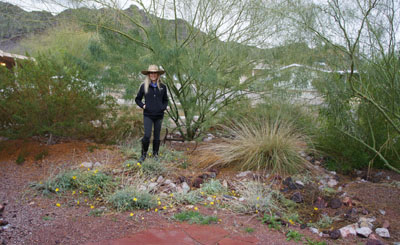When Deborah Tosline bought her mid-century home in Sunnyslope, she turned off the sprinkler system that provided the lifeline to the green lawn carpet in her front and backyards. Tosline transitioned the yard from grass to bare dirt and ultimately to a passive rainwater harvesting landscape with swales, rocky hillsides and flowering native vegetation.
To prepare the yard, Tosline photographed and mapped the locations where rain runoff flowed off the roof and across the yard during storms. She made measurements and prepared scaled drawings of the yard and features that she then used to design the new landscape including locations of channels, swales, hillsides and plants.

Deborah Tosline converted the grassy yard of her Sunnyslope home to a desert oasis that uses a passive rainwater harvesting system. She has created a DIY guide for others to convert their home landscapes, available for pre-order on her website, www.rainwaterharvestingdiy.com (photo by Teri Carnicelli).
A passive rainwater harvesting landscape captures water in depressions, also called swales, where the water is slowed to allow it to immediately soak into the ground. The term “active” rainwater harvesting means that water is collected and stored in tanks for later use.
Before any work started, the yard was blue staked to identify underground utilities and to avoid hazards during excavation and recontouring of the yard. The final design included two channels and six swales designed so that storm water would fill the swales before ultimately overflowing into the street, if needed.
The yard was finished in June 2014. A flagstone patio nestles next to a channel that leads to a depression surrounded by lacey plants, making an enchanted desert hummingbird and Monarch butterfly garden that will thrive on rainwater, provide shade, a native ecosystem and an urban outdoor respite.
It’s not the first time Tosline, who has Bachelor of Science degrees in geology and ecology, has personally converted her home’s yard from lush grassy landscaping to desert xeriscape with a passive rainwater collection system. In fact, she won an award for “Best Use of Water Harvesting” from the Arizona Department of Water Resources for her former Tucson home.
Tosline advises North Central residents to consider planting a passive rainwater harvesting landscape with desert flowers, bushes and trees to attract hummingbirds and butterflies and milkweed for Monarchs. “Save your water supplies for drinking, ease yard maintenance, make a pretty pollinator-attracting ecosystem and increase the resale value of your home with a delightful native habitat,” she says.
Tosline is taking pre-orders at www.rainwaterharvestingdiy.com for a two-page laminated guide to planning a passive rainwater harvesting DIY landscape.









































